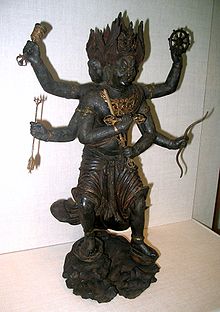- Kongō-Yasha Myō-ō
-
En el culto shingon del budismo japonés, el dios protector Kongō-Yasha Myō-ō (金剛夜叉明王) tiene tres caras amenazadoras y seis brazos (o una cara y cuatro brazos), y representa la fuerza. Se le sitúa en el norte.
El mantra de Kongō-Yasha Myō-ō es:
- 「おん ばさらやきしゃ うん」
- (on basarayakisha un)
Véase también
Wikimedia foundation. 2010.

